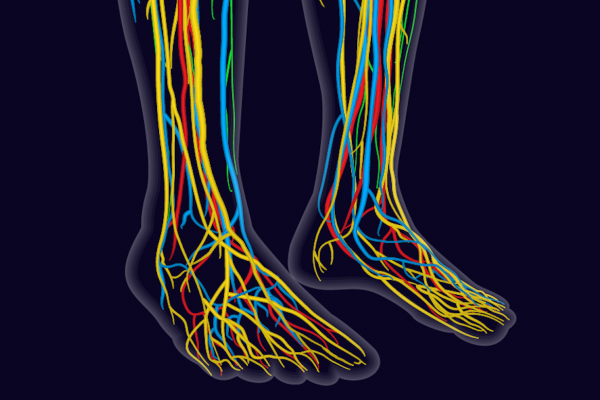Roswell Park offers innovative treatments for peripheral nerve tumors or injuries
While the brain and spinal cord make up the central nervous system – the “mainframe” of every human body — the tiny, fragile conduit nerves that connect it to the rest of the body are called peripheral nerves.
“We define peripheral nerves as the bundles of neurons that exit the spinal cord and travel through the body all the way to the tips of your fingers and tips of your toes, in a complex and delicate branching pattern,” explains neurosurgeon Lindsay Lipinski, MD, Assistant Professor of Oncology at Roswell Park Comprehensive Cancer Center.
Peripheral nerves control the body’s internal environment, sensation, voluntary and involuntary movement, and spinal cord reflexes, as well as muscle and tendon memory and learning. Damage to these nerves, from a tumor, injury, or trauma, can impact quality of life and daily functioning.
Any nerve injury or tumor can cause sensory changes such as numbness or tingling, or weakness in the muscle that the nerve supplies. Without adequate nerve supply, muscles can stop working completely within 12-18 months. For this reason, Dr. Lipinski advises people who experience nerve trauma or injury to seek treatment as soon as possible for the best outcomes. “If a person is evaluated two years after an injury, we can’t fix the nerve directly because the muscles will no longer be functional. They have already died,” she says, adding that there may still be other options for these patients to improve pain and function.
Special surgery for peripheral nerve tumors and injury
Tumors that form in or on a peripheral nerve can arise in any part of the body. Most are benign (not cancerous), but often require treatment because they cause nerve disruption, damage, or dysfunction of the nerve. Surgery to remove a tumor is typically the first line of treatment. However, to repair nerve damage from a tumor, or that resulted from injury, other surgical options may be necessary, which can include:
- Nerve grafting – taking a sensory nerve from another part of the body, or from a donor, and suturing it into the damaged nerve to help it to regenerate
- Nerve transfer – using a small part of a functional nerve to connect to and salvage muscle function when a nerve is too damaged to be repaired
- Tendon transfer – taking a tendon from another part of the body and using it to mimic and restore mechanical function to a muscle that is in danger of dying due to extensive nerve trauma
“When you can’t do direct nerve repair, nerve transfer is the next option. And if you can’t do a nerve transfer or the length of time since the trauma or injury has been too long, you look at tendon transfer,” Dr. Lipinski says.
Peripheral nerve repair is a rapidly evolving field that requires a lot of planning, a detailed physical exam, microscopic sutures, and a multidisciplinary approach to recovery for each patient, she adds. In addition to Dr. Lipinski, a neurosurgeon who also specializes in nerve surgery, Roswell Park’s team includes a plastic surgeon who specializes in hand surgery, physical therapists, and recovery specialists who work seamlessly to optimize the outcome for every patient.
“Treatment for peripheral nerve tumors and nerve injuries has changed a lot over the last decade. As the technology gets better, we’re seeing better and better outcomes. It’s definitely worthwhile for patients to seek options as to what can be done to improve their function and quality of life,” says Dr. Lipinski.
More information
Read more about peripheral nerve tumors and how specialists at Roswell Park treat this condition.
Tumor expertise expands to help other nerve injuries
As a comprehensive cancer center designated by the National Cancer Institute as one of the nation’s elite, Roswell Park is the only regional location that specializes in multimodality treatment of nerve tumors, such as:
- Schwannomas. These usually benign and slow-growing tumors can form anywhere in the body, but typically form in the cranial nerve that sends messages from the brain to the inner ear to manage sound and balance.
- Neurofibromas. These often-benign tumors are commonly found in people with the genetic condition neurofibromatosis (NFT1).
- Malignant peripheral nerve sheath tumors (MPNST). These cancerous tumors are deep, complex sarcomas that arise out of multiple nerves. Roswell Park also has a dedicated clinic for people diagnosed with any form of neurofibromatosis (NF1 and NF2-related schwannomatosis), which increases the risk for developing nerve tumors.NF1 patients undergo intensive surveillance to determine if deep-seated tumors are growing or changing in any way, and if there is any evidence of malignancy.
“Our expertise started with nerve tumor surgery but then blossomed to include surgery for nerve injuries, for nerve trauma, grafting of nerves and for functional repair of nerves,” Dr. Lipinski says. “In some ways it falls outside of our cancer mission, but it very much falls inside a unique set of capabilities we have here at Roswell Park,” she continues.
“We can provide treatment for patients who don’t have access to this type of service anywhere else in the region because it is so specialized. We just happen to have the overlapping interest and skillset and expertise to be able to serve those patients.”




